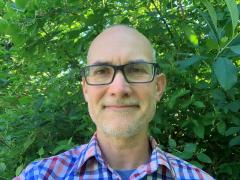Meet a Forester, Chad Davis
This month, we are pleased to feature Chad Davis, Director of State & Private Forestry with USDA Forest Service Regions 6 and 10.

What was your first position in the field of forestry?
Forest technician while pursuing an undergraduate degree in Environmental Policy at Duke University. I arranged my class schedule to allow for me to paint boundary lines and cruise timber for Bernard & Dryman Consulting Forestry in Hillsborough, NC.
How long have you been in your role?
Three months! Prior to State and Private Director for R6 & R10, I served as the Director of the Partnership & Planning Program at the Oregon Department of Forestry for 5 years.
What do you enjoy most about being a Western Forestry Leadership Coalition (WFLC) member?
I’m a collaborator first and foremost and I’m very interested to learn from other states and regions. We all have similar policy, similar objectives, yet very different social and political factors that provide place-based opportunities.
What would you do (for a career) if you weren’t doing this?
I’m a cycling-obsessed cyclist. I am proud to serve as the Board President for Cycle Oregon. I’d always rather be riding my bike or designing routes that take in the best paved AND gravel roads on offer. If I wasn’t in this role, I’d alternate between bikepacking the length of a mountain range (the Andes) and guiding small cycling adventures that feature epic climbs, sheep cheese, and the regional wine in Europe.
What is your favorite tree?
I’m bi-coastal, maybe? Before crossing the Mississippi, my favorite tree was Pinus palustris (longleaf pine). This historical source of turpentine grows in the most unique conditions, co-habitating as I first met the species, with a carnivorous plant, the Venus fly trap. That grass stage, whoa! I brought a seedling west with me and built a deep planter box for my apartment in Oregon. The tree never jumped out of the grass stage despite my multiple attempts to burn needles with a BBQ lighter.
My current love – which has been threatening to develop into a forearm tattoo for the better part of three years now – is Pinus albicaulis (whitebark pine). I’ve fallen head over heels for this species while backpacking my favorite Wilderness’ on the planet: Eagle Caps (NE Oregon) and Sawtooth (Idaho). The tenacity of this tree to withstand the harshest conditions results in art, with a silhouette of granite and blue, sparsely-clouded, skies.